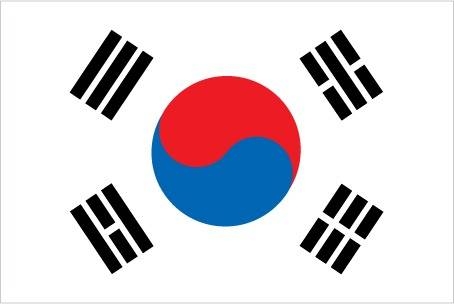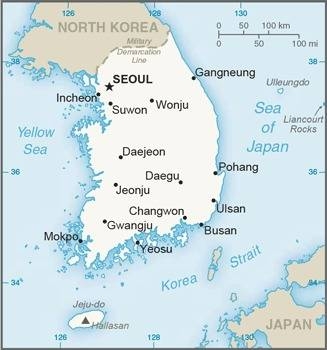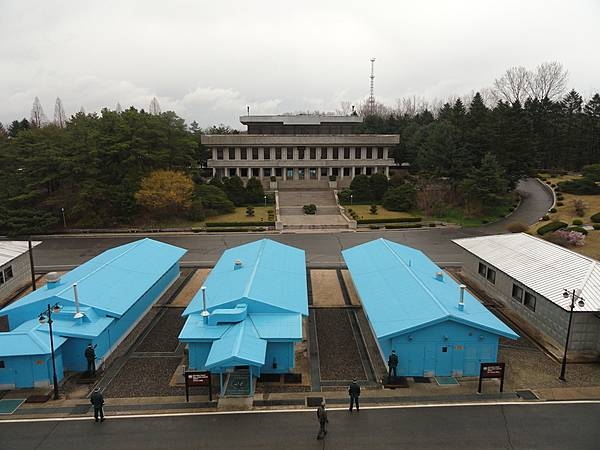164 South Korea

White with a red (top) and blue yin-yang symbol in the center. There is a different black trigram from the ancient I Ching (Book of Changes) in each corner of the white field. The South Korean national flag is called Taegukki. White is a traditional Korean color and represents peace and purity. The blue section represents the negative cosmic forces of the yin, while the red symbolizes the opposite positive forces of the yang. Each trigram (kwae) denotes one of the four universal elements, which together express the principle of movement and harmony.
Flag courtesy of the CIA World Factbook

Map courtesy of the CIA World Factbook

The Joint Security Area (JSA, often referred to as the Truce Village or Panmunjom) is the only portion of the Korean Demilitarized Zone (DMZ) where North and South Korean forces stood face-to-face. In 2018, North and South Korean officials agreed to clear the JSA of all landmines, weapons, and guard posts. This withdrawal was completed on 25 October 2018 and the JSA now contains just 35 unarmed security guards. The area is slated to mainly become a tourist attraction. The photo shows South Korean soldiers standing guard at the JSA between the blue UN buildings. The white buildings are North Korean. This view is from the House of Freedom in South Korea looking towards the three-story Panmungak Hall in North Korea.
Photo courtesy of the CIA World Factbook
Government
According to Britannica, the government instituted after a constitutional referendum in 1987 is known as the Sixth Republic. The constitutional structure is patterned mainly on the presidential system of the United States and is based on separation of powers among the legislature, the executive, and the judiciary. The government system, highly centralized during most of South Korea’s existence, is less so under the Sixth Republic. The president, since 1987 chosen by direct popular election for a single five-year term, is the head of state and government and commander of the armed forces. The State Council, the highest executive body, is composed of the president, the prime minister, the heads of executive ministries, and ministers without portfolio. The prime minister is appointed by the president and approved by the elected National Assembly (Kuk Hoe).
Legislative authority rests with the unicameral National Assembly. The powers of the National Assembly, which was reinstated in 1980 after a period of curtailment, were strengthened in 1987. Its 300 members are chosen, as previously, by a combination of direct and indirect election to four-year terms.
South Korea has a multiparty system in which two parties have tended to dominate, although their names and composition have often changed. In the early 21st century the conservative Grand National Party and the centrist-liberal Democratic Party were dominant.
South Korea is divided administratively into the nine provinces (do or to) of Cheju, North Chŏlla, South Chŏlla, North Ch’ungch’ŏng, South Ch’ungch’ŏng, Kangwŏn, Kyŏnggi, North Kyŏngsang, and South Kyŏngsang; and the metropolitan cities (kwangyŏksi) of Seoul, Pusan, Taegu, Inch’ŏn, Kwangju, Taejŏn, and Ulsan. Each has a popularly elected legislative council. Provinces are further divided into counties (gun) and cities (si), and the large cities into wards (ku) and precincts (tong). Provincial governors and the mayors of province-level cities are popularly elected.
The judicial branch consists of the Supreme Court, three appellate courts (High Courts), district courts, a family court, a patent court, and administrative and local courts. The Supreme Court is empowered to interpret the constitution and all other state laws and to review the legality of government regulations and activities. The chief justice is appointed by the president with the consent of the National Assembly; the mandatory retirement age for the chief justice is 70. All other Supreme Court justices are appointed by the president upon the recommendation of the chief justice; they serve six-year terms, to which they may be reappointed, and the retirement age is 65.
Office of Civil Aviation (KOCA)
The Office of Civil Aviation (KOCA) is committed to making air travel safer and more convenient by supporting Korea’s aviation industry so that the Republic of Korea emerge as a true global aviation leader. Air transport business brings them tremendous benefits in terms of economic, social and cultural development.
Airspace
SkyVector – Google Maps – ADS-B Exchange
ICAO countries publish an Aeronautical Information Publication (AIP). This document is divided into three parts: General (GEN), En Route (ENR) and Aerodromes (AD). ENR 1.4 details the types of airspace classes they chose to adopt from classes A through G.
Drone Regulations
Korea Aero Models Association – Hobby Association Rules
Advanced Air Mobility (AAM) Regulations & Policies
2025 – Enforcement Decree of the Act on the Promotion of and Support for Utilization of UAM
2022 – S. Korea out to set legal grounds for urban air mobility H2
2021 – K-UAM Roadmap
2021 – K-UAM Grand Challenge Korea
Bilateral agreements facilitate the reciprocal airworthiness certification of civil aeronautical products imported/exported between two signatory countries. A Bilateral Airworthiness Agreement (BAA) or Bilateral Aviation Safety Agreement (BASA) with Implementation Procedures for Airworthiness (IPA) provides for airworthiness technical cooperation between the FAA and its counterpart civil aviation authorities.
Bilateral Aviation Safety Agreement – Executive Agreement
Implementation Procedures for Airworthiness
Implementation Procedures for Airworthiness, Amendment 1 to Revision 1
Addendum to Implementation Procedures for Airworthiness with the Korea Office of Civil Aviation
Advanced Air Mobility (AAM) Declaration of Cooperation
2016 Notification of Policy Deviation Memorandum for FAA Order 8130.21H
Obtaining Certification Approval from this Country
Advanced Air Mobility (AAM) News
2025 – Korean Air Completes Country’s First UAM Flight Demonstration
2025 – Korean Air Selects Archer As Its Exclusive Partner To Introduce EVTOL Aircraft In Korea
2025 – PLANA preorders 20 VONAER hybrid eVTOL aircraft
2025 – Skyports to establish vertiport network for Jeju Island
2025 – Eve, UI Helicopter to collaborate on AAM in South Korea
2025 – Korean Air to build UAM, aviation safety hub in South Korea
2025 – Hanjin, LS Group to collaborate on UAM ecosystem
2025 – Eve Air Mobility and UI Helicopter Collaborate to Accelerate Advanced Air Mobility in South Korea
2025
Video courtesy of Advanced Air Mobility Institute from the January 2025 Global AAM Forum. Complete session for Day 2 of this Forum is available on the Advanced Air Mobility Institute YouTube Channel
2024 – Joby Becomes First Company to Fly in Korea’s K-UAM Grand Challenge
2024 – UrbanV Teams with Korean Airport Firm to Build AAM Network
2024 – Firstco Presents Vertiport Insights at World Smart City Expo
2024 – POSCO to Participate in Joint Research to Build Vertiports
2024 – Skyports partners with Jeju Air to develop vertiports in Korea
2024 – Skyports partners with Korea’s leading domestic carrier on vertiport development
2024 – Moviation launches air taxi service in South Korea
2024 – Kakao Mobility partners with Archer on UAM in South Korea
2024 – Incheon’s AAM Concept of Operations Released
2024 – Incheon Metropolitan City, IAIAC, and MITRE Unveil Advanced Air Mobility Concept of Operations
2023 – Eve Air Mobility and Jeju Air Release Concept of Operations for UAM in South Korea
2023 – Skyports Drone Services strengthens presence in Korea
2023 – Vertical Aerospace expands presence in South Korea
2023 – Vertical Aerospace expands in Asia-Pacific with VX4 preorder from Kakao Mobility
2023 – PLANA, South Korean AAM developer, expands to the U.S.
2023 – Vertical’s South Korea AAM partner to link air taxis in mobility app
Short Essay Questions
Scenario-Based Question
You have been hired by a Drone Startup Company. Your boss has immediately assigned this job to you.
They need you to prepare a one-page memo detailing the legalities of using a drone to film the DMZ, pictured above.
They need you to mention any national laws and local ordinances.
They specifically want to know what airspace (insert pictures) you will be operating in and whether or not you need an airspace authorization.
Does it matter whether or not you are a citizen of the country?
Lastly, there is a bonus for you if, as you scroll through this chapter, you find any typos or broken links!
Short Essay Questions
- What are the drone categories?
- How is registration addressed?
- How is remote ID addressed?
- What are the model aircraft rules?
- What are the commercial drone rules?
- Are there waivers or exemptions to the rules? If so, for what?
- Would you share a link to an interactive airspace map?
- How is BVLOS addressed?
- How can you fly drones at night?
- How can you fly drones over people?
- Where do you find drone NOTAMs?
- What are the rules for drone maintenance?
- What are the rules for an SMS program?
- What are some unique rules not mentioned above?
- What are the C-UAS rules?
- What are the AAM rules?

